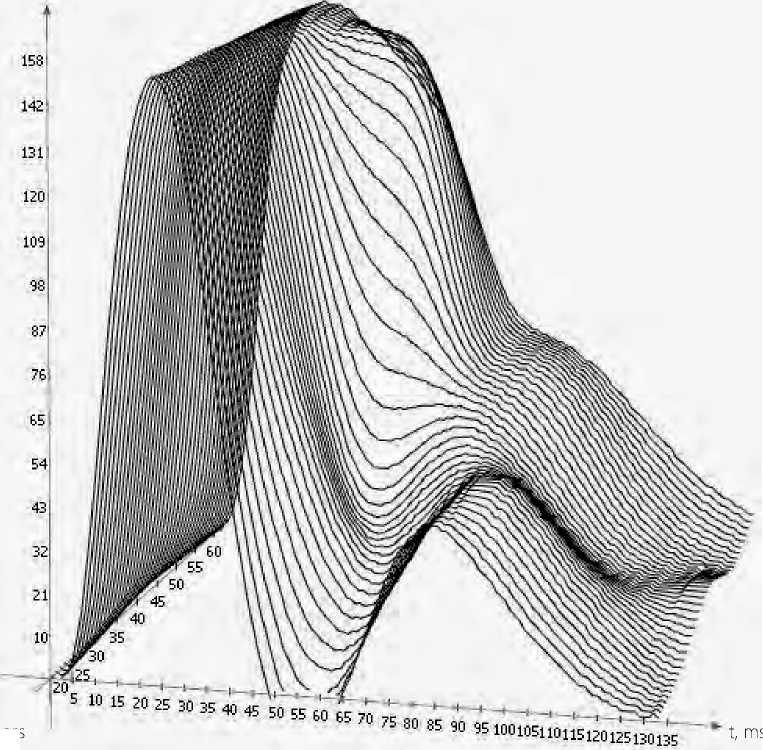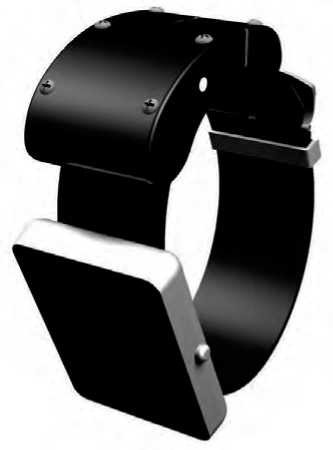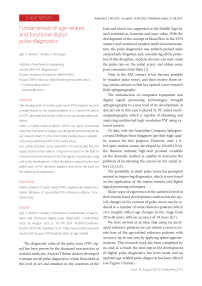Fundamentals of age-related and functional digital pulse diagnostics
Автор: Igor S. Yavelov, Andrey V. Rochagov
Журнал: Cardiometry @cardiometry
Статья в выпуске: 19, 2021 года.
Бесплатный доступ
The development of a matrix pulse wave (PW) analyzer became a reality thanks to the implementation of a 3-point PW sensor in 2017, when the test results of the mock-up sample were published. Later, a mobile medical device, which was given provisional name the Pranayama Gadget, was designed and developed by our research team. It is the first mobile medical device capable of tracing undistorted PW of the radial artery. Our article presents some algorithms for processing the PW signal, based on the authors long-term research in the field of measurement and analysis of the PW signals. In particular, a big role in the development of this discipline is played by the new spline base of PW reference patterns that forms the basis for the digital pulse diagnostics
Matrix analyzer of pulse waves (PW), Digital pulse diagnostics, Spline database of age-related PW reference patterns, Functional load
Короткий адрес: https://sciup.org/148320559
IDR: 148320559 | DOI: 10.18137/cardiometry.2021.19.113116
Текст научной статьи Fundamentals of age-related and functional digital pulse diagnostics
Imprint
Igor S. Yavelov*, Andrey V. Rochagov. Fundamentals of age-related and functional digital pulse diagnostics. Cardiometry; Issue 19; August 2021; p. 113-116; DOI: 10.18137/cardiome-try.2021.19.113116; Available from: issues/no19-august-2021/fundamentals-of-age-related
The diagnostic value of the pulse wave (PW) signal has been proven by the thousand-year practice of oriental medicine. Ancient Tibetan doctors developed a unique tactile pulse diagnostics, which flourished at the level of art and intuition in the countries of the
East and which was supported in the Middle Ages by such scientists as Avicenna and some other. With the development of the concept of blood flow in the XVII century and creation of modern medical instrumentation, the pulse diagnostics was unfairly pushed aside and partially forgotten, and, considering all the potential of this discipline, modern doctors can only count the pulse rate on the radial artery and obtain some poor comments from there [1].
Only in the XIX century it has become possible to visualize pulse waves, and then receive them using various sensors so that has opened a new research field: sphygmography.
The introduction of computers equipment and digital signal processing technologies brought sphygmography to a new level of its development. A special role in this case is played by PC-aided mech-anopulsography, which is capable of obtaining and analyzing undistorted high-resolution PW using external sensors.
To date, only the Australian Company Sphygmo-cor and HelStats from Singapore use their high-quality sensors for this purpose. However, only a fiber-optic matrix sensor developed by IMASH RAS, the Russian national high-tech product available on the domestic market, is capable to overcome the problem of positioning the sensor on the radial artery [2,3,4,5].
The possibility to study pulse waves has prompted interest in improving diagnostics, which is now based on the application of the matrix sensors and digital signal processing techniques.
Many years of experience of the authors hereof in their research and development confirm that the typical changes in the contour of pulse waves can be reduced to a number of some reference patterns which very roughly reflect age changes in the range from 20 to 60 years, with an accuracy of 10 years [6,7].
We have arrived at an idea, that using six developed reference patterns we can obtain a more accurate base of the age-related reference patterns with accuracy up to one year by applying spline approximations. This research work has been completed by us, and, as a result, the next step in the development of digital pulse diagnostics has been made and an updated age-related pulse diagnosis has been offered (see Figure 1 herein).
YO, years
A, B

Figure 1. Age-related spline database of radial artery pulse wave reference patterns from 20 to 60 years (age discreteness is 1 year).
Considering the developments of the previous period it follows that typical changes in the pulse wave contour occur not only due to age-related loss of elasticity and due to sclerosis of the vascular wall, but also when the functional state of the body changes: physical activity, food consumption, sleep, rest, fatigue etc. Basically, these effects are associated with specific changes in the peripheral vascular resistance and reflect various functional loading cases. Taking into account these changes, a diagnostic map of age-linked functional diagnostics has been created as shown in Figure 2 herein.
Thus, as a result of the application of spline approximations, a diagnostic table has been produced by us, where instead of 9 typical cells with pulse wave reference patterns an updated database for 421 cells has been prepared. Accordingly, the capabilities of this database in the context of clarifying the diagnosis and reducing the time expenditures required for its formulation are much greater.
The procedure for using our updated diagnostic map should contain certain stages, namely:
-
a) Recognition of pulse waves according to the age should be carried out in a patient in his/her fully relaxed state;
-
b) After identifying the age, functional tests are carried out (for example, holding the breath, fitness or 15-30 squats), and the actual wave pattern should be referred to the functional scale, i.e. horizontally.
This article does not address the issues on specific diagnostics of the state of all body systems, since this is the subject of further development of diagnostics taking into account heart rate variability.
In conclusion, it should be noted that the described diagnostic methods have been translated into the above mentioned mobile medical device (developed by IMASH RAS) as exhibited in Figure 3 herein.
It is a kind of “smart watch” furnished with an original function of a human pulse wave analyzer. This function has been realized thanks to the implemen-
Age, years (YO)
|
55 |
56 |
57 |
58 |
59 |
60 |
|||||
|
54 |
55 |
56 |
57 |
58 |
59 |
60 |
||||
|
53 |
54 |
55 |
56 |
57 |
58 |
59 |
60 |
|||
|
52 |
53 |
54 |
55 |
56 |
57 |
58 |
59 |
60 |
||
|
51 |
52 |
53 |
54 |
55 |
56 |
57 |
58 |
59 |
60 |
|
|
50 |
51 |
52 |
53 |
54 |
55 |
56 |
57 |
58 |
59 |
60 |
|
49 |
50 |
51 |
52 |
53 |
54 |
55 |
56 |
57 |
58 |
59 |
|
48 |
49 |
50 |
51 |
52 |
53 |
54 |
55 |
56 |
57 |
58 |
|
47 |
48 |
49 |
50 |
51 |
52 |
53 |
54 |
55 |
56 |
57 |
|
46 |
47 |
48 |
49 |
50 |
51 |
52 |
53 |
54 |
55 |
56 |
|
45 |
46 |
47 |
48 |
49 |
50 |
51 |
52 |
53 |
54 |
55 |
|
44 |
45 |
46 |
47 |
48 |
49 |
50 |
51 |
52 |
53 |
54 |
|
43 |
44 |
45 |
46 |
47 |
48 |
49 |
50 |
51 |
52 |
53 |
|
42 |
43 |
44 |
45 |
46 |
47 |
48 |
49 |
50 |
51 |
52 |
|
41 |
42 |
43 |
44 |
45 |
46 |
47 |
48 |
49 |
50 |
51 |
|
40 |
41 |
42 |
43 |
44 |
45 |
46 |
47 |
48 |
49 |
50 |
|
39 |
40 |
41 |
42 |
43 |
44 |
45 |
46 |
47 |
48 |
49 |
|
38 |
39 |
40 |
41 |
42 |
43 |
44 |
45 |
46 |
47 |
48 |
|
37 |
38 |
39 |
40 |
41 |
42 |
43 |
44 |
45 |
46 |
47 |
|
36 |
37 |
38 |
39 |
40 |
41 |
42 |
43 |
44 |
45 |
46 |
|
35 |
36 |
37 |
38 |
39 |
40 |
41 |
42 |
43 |
44 |
45 |
|
34 |
35 |
36 |
37 |
38 |
39 |
40 |
41 |
42 |
43 |
44 |
|
33 |
34 |
35 |
36 |
37 |
38 |
39 |
40 |
41 |
42 |
43 |
|
32 |
33 |
34 |
35 |
36 |
37 |
38 |
39 |
40 |
41 |
42 |
|
31 |
32 |
33 |
34 |
35 |
36 |
37 |
38 |
39 |
40 |
41 |
|
30 |
31 |
32 |
33 |
34 |
35 |
36 |
37 |
38 |
39 |
40 |
|
29 |
30 |
31 |
32 |
33 |
34 |
35 |
36 |
37 |
38 |
39 |
|
28 |
29 |
30 |
31 |
32 |
33 |
34 |
35 |
36 |
37 |
38 |
|
27 |
28 |
29 |
30 |
31 |
32 |
33 |
34 |
35 |
36 |
37 |
|
26 |
27 |
28 |
29 |
30 |
31 |
32 |
33 |
34 |
35 |
36 |
|
25 |
26 |
27 |
28 |
29 |
30 |
31 |
32 |
33 |
34 |
35 |
|
24 |
25 |
26 |
27 |
28 |
29 |
30 |
31 |
32 |
33 |
34 |
|
23 |
24 |
25 |
26 |
27 |
28 |
29 |
30 |
31 |
32 |
33 |
|
22 |
23 |
24 |
25 |
26 |
27 |
28 |
29 |
30 |
31 |
32 |
|
21 |
22 |
23 |
24 |
25 |
26 |
27 |
28 |
29 |
30 |
31 |
|
20 |
21 |
22 |
23 |
24 |
25 |
26 |
27 |
28 |
29 |
30 |
|
20 |
21 |
22 |
23 |
24 |
25 |
26 |
27 |
28 |
29 |
|
|
20 |
21 |
22 |
23 |
24 |
25 |
26 |
27 |
28 |
||
|
20 |
21 |
22 |
23 |
24 |
25 |
26 |
27 |
|||
|
20 |
21 |
22 |
23 |
24 |
25 |
26 |
||||
|
20 |
21 |
22 |
23 |
24 |
25 |
|||||
FITNESS MIDDLE ALARM
Figure 2. Diagnostics map of the pulse wave analyzer (age-related functional diagnostics)

Figure 3. The Pranayama Gadget tation of a matrix fiber-optic sensor. The device is capable of determining blood pressure with the proper medical accuracy without squeezing the blood vessels with a cuff. In addition, it has the capability of the age-related diagnostics of the cardiovascular system with an accuracy step up to 1 year, and it can also diagnose all body systems using the heart rate variability analysis. After the diagnosis is made, the gadget determines a code corresponding to the detected disease and offers options of the targeted delivery of an increased amount of blood to the affected organ identified. Treatment is carried out by organizing a certain respiratory rate, which, in its turn, generates certain heart rate modulations. As a result, the affected organ receives an additional amount of blood and recovers.
Conflict of interest
None declared.
Список литературы Fundamentals of age-related and functional digital pulse diagnostics
- Yavelov I.S., Rochagov A.V. Computer pulse diagnosis and analyzer “Pulse”. Moscow, Izhevsk: Research Center “Regular and chaotic dynamics”, 2006. 160 p. [in Russian]
- Yavelov IS. A method for measuring blood pressure and a device for its implementation. Pat. RF No. 2685470 dated 18.04. Dec 2019. [in Russian]
- Yavelov IS, Rochagov AV, Yavelov OI, Pleshakov KV. Features of measurement of pulse wave indicators by single-and multi-point sensors. Biomedical Radioelectronics. 2017;3:14-21.
- Yavelov IS, et al. Investigation of matrix pulse wave sensors. Instruments and Experimental Techniques. 2020;3:125-30.
- Yavelov IS, et al. The sensitivity of the pulse wave sensor to a change in the signal measurement point. Biomedical Engineering. 2019;2(314):41-3.
- Yavelov IS. Mechanopulsography and the main phenomena of the cardiovascular system. Moscow, Izhevsk: Institute of Computer Research, 2020. 196 p. [in Russian]
- Yavelov IS, Zholobov AV, Rochagov AV, Yuganov YV. Digital heart rate diagnostics. Cardiometry. 2019;15:43-8.


